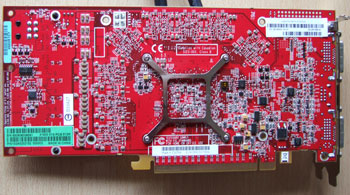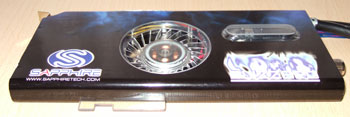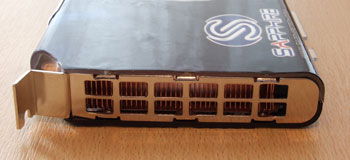Sapphire TOXIC Radeon X1900 XTX
Now before we start, let us point out that the sample we tested differs from final production versions in a couple of ways. Firstly Sapphire will change the backplane plate on the graphics card for a single-slot version. There's no need for it to be dual-slot as you'll see in our pictures, and Sapphire know that. Secondly, Sapphire have upped the out-of-the-box clocks for the TOXIC Radeon X1900 XTX from stock to 675/800, equating to a 25MHz boost on memory and core.Keep that in mind as we talk about it.
TOXIC? TOXIC!
The TOXIC cooler is an almost complete replacment for the standard one with only the retention bracket on the rear kept. The block comes preattached to the card and pre-plumbed to the all-in-one, fits-in-a-mainboard-slot reservoir, pump and heat exchanger combo. The use of the standard retention bracket on the rear means that you could retro fit the TOXIC hardware to your existing high-end X1K hardware, and indeed Sapphire have plans to do so. Nothing's been announced yet, though.As you can see, Sapphire also fit some heatsinks to the DRAM ICs on the board, doing the job of the original equipment cooler. Sapphire don't do anything with the FET bank cooler on the far right of the board, near the power connector, though. Nude, you can see the Theater 200 chip for video input processing and the dual-slot backplane of the tested sample that'll disappear on retail ones.
If you couldn't see the two pipes at the top of that shot, you couldn't tell me it was any different from a regular X1900 XTX.
It's the all-in-one cooler that's the interesting bit, although the waterblock does look swish.
You can see that the device can sit in a spare mainboard slot and be retained to your chassis, so technically it's still a two-slot cooling solution, but then the donor board was two-slot as well. An 80mm fan spins at a maximum of 2500rpm, controlled by a high/low switch on the top edge of the unit. Air is pushed over a heat exchanger with copper fins and a small inline pump does the hard work.
That side is where air exits the chassis the TOXIC is integrated to, and the following side is where you can top it up or refill it if needs be (although it does come prefilled).
You can see inlet and outlet pipes close together on the right side as we look at it (the power connector comes out of there too, but you can't see it in that pic) and the thin single-slot dimensions of that part of the TOXIC hardware make themselves known.
With it coming pre-assembled and pre-filled, all you do is put TOXIC hardware and cooled X1900 XTX into the right slots and retain them to your case (yes, it is that simple), before connecting a spare 4-pin power connector from your PSU to the waiting cable.
Noise
We'll cover overclocking and thermal performance later on, but it's worth covering noise now. While we're not sure about Sapphire's 18/26 dBA claims (low/high fan settings), it's still massively less noisy than the stock X1900 XTX cooler. We barely heard it over the noise of our test system and thus the main issue with the X1900 XTX is solved in one fell water-cooled swoop.Let's look at the bundle and presentation before we get on to the extra benefits the cooler brings.














